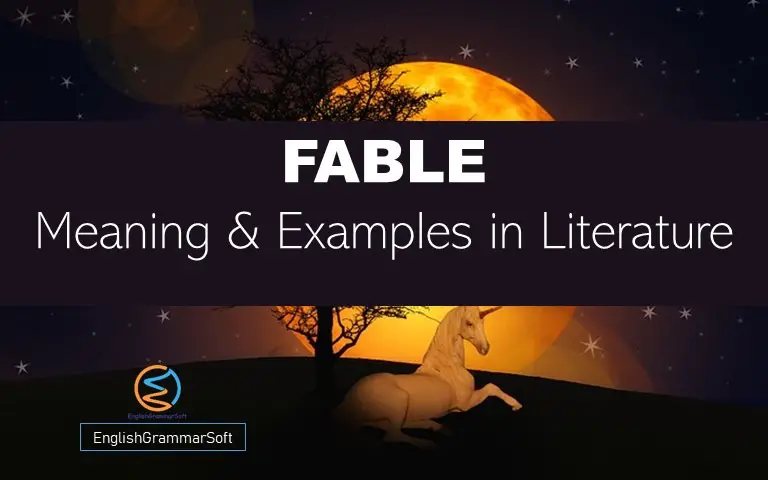Fable Meaning and 3 Examples in Literature (Literary Devices)
Fable Meaning and Examples in Literature
Fable
It was first known use in 14th century.
History
Middle English, borrowed from Anglo-French, going back to Latin fibula “talk gossip, account, tale, legend, “from fa-stem of for, fari “to speak, say”.
The beast fable is extremely ancient, evidenced from Egypt, Greece, India and presumably cognate with the development of a self-conscious folklore in primitive cultures.
The Western tradition derives largely from the fables of Aesop, a Greek slave who lived in Asia Minor in the sixth century BC. His work is not known directly, but has been transmitted through elaborations by such writers as Phaedrus and Babrius.
Definition
a. A succinct fictional story, in prose or verse, that features animals, legendary creatures, plants, inanimate objects, or forces of nature that are anthropomorphized, and that illustrates or leads to a particular moral lesson, which may at the end be added explicitly as a concise maxim or saying.
b. A short moral tale, in verse or prose, in which human situations and behavior are depicted through (chiefly) beasts and birds, or gods or inanimate objects. Human qualities are projected onto animals, according to certain conventions (e.g. malicious craftiness for the fox).
Kinds of Fables
Fables are ironic and realistic in tone, often satirical, their themes usually reflecting on the commonsense ethics of ordinary life: they dramatize the futility of relinquishing a small profit for the sake of larger (but hypothetical) future gains, of the weak attempting to take on the powerful on equal terms, the irony of falling into one’s own traps, etc.
Such themes are close to the advice of proverbs, and the moral point of a fable is usually announced epigrammatically by one of the characters at the end.
Examples of Fable
- Slow and steady wins the race
- Fox and the grapes
- Lion and the Mouse
- The ant and the Grasshopper
Fables in Literature
The most famous medieval example is Chaucer’s ‘Nun’s Priest’s Tale’.
The fable achieved greater sophistication in the hands of Jean de la Fontaine (1621-95), whose verse fables revived the fashion throughout the Europe of the seventeenth and eighteenth centuries. England’s representative in this mode was John Gay (1685-1732). In Germany, G.E. Lessing (1729-81) preferred the simpler model of Aesop to the refined modern version.
The fable had twentieth-century practitioners, too. George Orwell’s Animal Farm (1945), sometimes seen as an allegory, employed the beast fable as the vehicle for an extended Satire on the totalitarian state. In America, James Thurber contributed Fables for our Time (1940). An Introduction (2003); Jayne Elizabeth Lewis, the English Fable: Aesop and Literary Culture, 1651-1740 (1996).
Fable in “Mother, Nurse, and Fairy” by John Gay.
“Give me a son, grant me an heir!” The fairies granted her the prayer. And to the partial parent’s eyes Was never child so fair and wise; Waked to the morning’s pleasing joy, The mother rose and sought her boy. She found the nurse like one possessed, Who wrung her hands and beat her breast. “What is the matter, Nurse—this clatter: The boy is well—what is the matter?”
“Lion, Tiger, and Traveler” by John Gay
“A tigress prowling for her prey Assailed a traveller on his way; A passing lion thought no shame To rob the tigress of her game. They fought: he conquered in the strife; Of him the traveller begged for life. His life the generous lion gave, And him invited to his cave. Arrived, they sat and shared the feast”.
“Animal Farm” by George Orwell’s
“The creatures outside looked from pig to man, and from man to pig, and from pig to man again; but already it was impossible to say which was which”.
Here Orwell extends the concept of anthropomorphism by having some of his characters become more and more like humans. At first, the pigs oppose mankind and everything related to humans. They slowly become more and more like them, until no one can tell the difference. The other animals remain animals.
Many fables are found in the Sanskrit works called Panchatantra and Hitopadesa. The stories in Persian contained in Anwar-i-Suhaili by Waiz Kashfi are also fables.
The fables of classical literature in which birds and beasts are made to think, speak ad act like men, all teach some moral. The fable of the Old Man, his Sons and the Ass (for example) shows the folly of attempting to please everyone. The fable of the Bundle of Sticks, which the young men could not break as long as they remained tied together, shows the power and value of union.
Further Reading
- Life Lessons From Aesop’s Fables
- Figures of Speech with Examples
- Antithesis Examples in Literature
- Euphemism Figure of Speech
- What is a simile in literature? How to write a good simile?
- 12 Types of Metaphor with Examples
- Apostrophe as a Figure of Speech
- Personification with Examples
- Hyperbole Definition and Examples
- What is Epigram in Figure of Speech?






